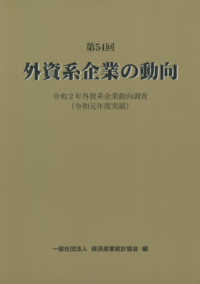Full Description
In 2010, when photographer Krista Elrick began traversing John James Audubon country in search of the birds the nineteenth-century American naturalist observed, painted, and wrote about, she encountered scarcely a sighting. Instead, she found the lushly forested watersheds and waterways that Audubon had passionately described in his journals vastly altered with many of the bird species extinct and their supporting habitat all but disappeared. Industrial buildings, parking lots, and strip malls had overtaken much of the area, edging out the natural world. It was a country no more.
With a vintage Hasselblad film camera in hand, Elrick traveled more than 45,000 miles over ten years, following in the footsteps of Audubon as she sought clues to what had happened to these places and to the animals and peoples who once lived there. Starting at his home in Mill Grove near Philadelphia, she retraced Audubon's many journeys to the bluffs of Cincinnati overlooking the Ohio River, to the key port town of Henderson, Kentucky, to the confluence of the Ohio and Mississippi Rivers and the burgeoning frontier towns of Natchez in Mississippi and St. Francisville and New Orleans in Louisiana, then back east to Charleston in South Carolina and St. Augustine and Key West in Florida on the Atlantic Coast, and on to far West and the confluence of the Missouri and Yellowstone Rivers and, on a final journey, to Audubon's gravesite in the Trinity Church Cemetery in New York City. What a journey.
Audubon's approach to painting birds was unique. He would kill however many birds he needed, brought them back to a studio or a room where he was lodging, constructed scenes with backdrops from a variety of locales, and rendered them in the paintings we revere today. Elrick responds to that approach by creating collages of her own, integrating the black-and-white images she made of the places Audubon and she traveled through with historic bank notes, period maps, and other ephemera that yield fascinating insights into the landscapes of Audubon today. And we see the changes and resulting effects on the natural world and its species as well as on the lives of the Native Americans and African Americans who once occupied the areas during Audubon's day.
In her research Elrick also discovered - as his biographers have - that Audubon himself was something of an enigma, a fabulist who told enchanting yet often conflicting stories about his own history and identity and what he saw in the field. Elrick's book offers us a fascinating compendium that gives us a fresh and provocative perspective on Audubon - the man and the artist - his times and enduring legacy.







